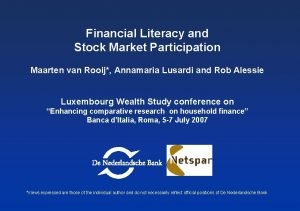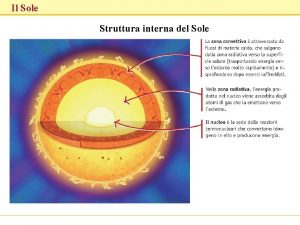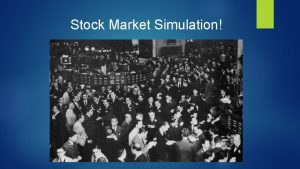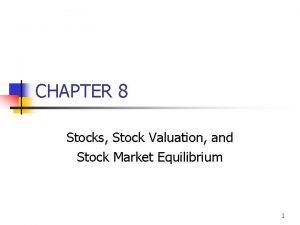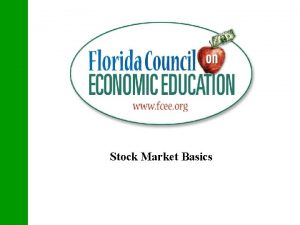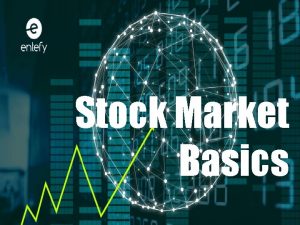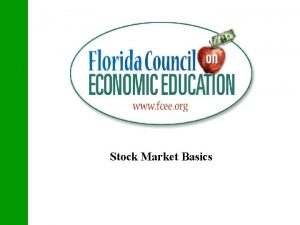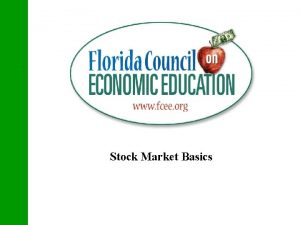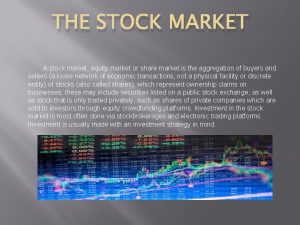Stocks and the Stock Market A sole proprietor













- Slides: 13


Stocks and the Stock Market A sole proprietor (sole owner) is someone who owns and manages a firm and has unlimited liability for the firm’s debts. Investor who owns stock in a firm organized as a corporation (legal entity run by boards of directors who appoint CEO) is protected by limited liability (legal provision shielding stockholder from losing more than they invested in the firm). A stockholder (or shareholder) has a legal claim on the firm’s profits and on its equity (assets minus liabilities) paid out through dividends. Preferred stockholders have no voting rights but receive a fixed dividend set when the stock is issued. Common stockholders or residual claimants have voting rights and receive a dividend that fluctuates as the profitability of the corporation varies over time. Firm’s market capitalization is the total market value of a firm’s common and preferred stock.

How and Where Stocks Are Bought and Sold Only 5, 100 of the 5 million U. S. corporations are publicly traded companies (sell stock in the U. S. stock market). Others are private firms (no stock issued). The NYSE is an example of a stock exchange (a physical location where stocks are traded face-to-face by members on a trading floor or electronically – majority). In OTC market securities are traded by dealers linked by ECN (e. g. , NASDAQ).

Measuring the Performance of the Stock Market Stock market index (price-weighted DJIA or value-weighted S&P 500, NASDAQ) average of stock prices used to measure overall performance of the stock market. All three follow similar patterns but have different accents. Stock price fluctuations affect households’ and firms’ spending (and the economy) but increases uncertainty and can postpone spending. Stock market is important source of funds for corporations and makes up significant portion of household wealth (households spend ↑/↓ as their wealth ↑/↓). Stock prices increase 1995 -2000 increased wealth by $9 trillion. Stock prices decrease 00 -02 & fall 07 -spring 09 wiped out $7 & $8. 5 trillion in wealth.

Should You Invest in the U. S. Stock Market? The financial crisis of 2007– 2009 devastated the U. S. stock market: DJIA dropped over 50%. The value of the mutual funds held by households dropped by almost $2 T. Investors’ participation in the stock market is affected by their expected returns. Research: investors experiencing bear markets (20% ↓) often reluctant to invest later. So, the financial crisis of 2007– 2009 may have a long-lasting effect on investors. Should you as young investor stay out of stock market? Based on data of historical returns, the longer your time horizon, the greater the gap between investments in CDs, Treasury bills, and stocks.

Investing in Stock for One Year The required return on equities (r. E) compensates for the risk of investing in stock. For the firm, this is the return needed to attract investors, or equity cost of capital. The equity premium is the return required to invest in equities rather than T-bills. Its components are Systematic (market) risk –that affect all stocks and Unsystematic (idiosyncratic) risk – that affects particular stock. Example: You expect to sell Microsoft stock next year for $32, immediately after it pays $0. 60 dividend. How much to pay for it if required return on equity is 10%? Price of any asset is PV of cash flows from owning it: ($32 + $0. 6) / 1. 1 = $29. 64 Stock % Ret = (Sell P + Div – Buy P)/Buy P = Div / Buy P + (Sell – Buy P)/Buy P Dividend Yield + Capital Gains Yield Double taxation of dividends causes inefficiencies (investors do not buy stocks, firms retain profits). Taxing capital gains creates lock-in effect (investors reluctant to sell). In 2003, Congress reduced div and capital gains tax from 35% to 15%, lowering inefficiencies but adversely affecting the distribution of after-tax income. In 2012, President Obama proposed raising taxes to reduce the perceived inequity.

The Gordon Growth Model To avoid the need to estimate future price in order to find the current price: Assume that stock is held forever: Forcing us to make assumptions about dividends in order to be able to solve. 1. Constant (zero growth) dividends: Divt = Divt-1 Price = PVP = Div / rp

Rational Expectations and Efficient Markets Expectations are important in the economy because many transactions require participants to forecast the future. Adaptive Expectations versus Rational Expectations Adaptive expectations: People make forecasts of future values of a variable using only past values of the variable. Rational expectations: People make (optimal) forecasts of future values of a variable using all available information. If is the actual stock price and is the optimal forecast, then no one can accurately forecast the size of the forecast error:

The Efficient Markets Hypothesis • Applies rational expectations to financial markets • Equilibrium security’s price reflects all available info & equal its fundamental value Based on the definition of all available info, stock prices reflect info derived from Weak form EMH – market trading data (historical prices, volume and short interest) Semi-strong EMH – all publicly available data Strong EMH – all relevant info including inside (illegal to use for trading) An Example of the Efficient Markets Hypothesis Because stock prices reflect all available info on fundamental value, they constantly change as news affects fundamental value, making them unpredictable or random walk. Monday 10: 14 am - Microsoft just paid $0. 90 dividend, expected to grow at 7%. - Since required return is 10%, stock sells for $32. 10: 15 am - News releases: Sales of latest version of Windows are higher than expected - Dividend growth revised to 8% increasing fundamental value to $48. 6 - Investors with rational expectations buy Microsoft, increasing demand price until it reaches the new fundamental value of the stock at $48. 6 Self-interested actions of informed traders cause available information to be incorporated into the market prices.

Efficient Markets and Investment Strategies Portfolio Allocation • EMH implies that we should hold a diversified portfolio of stocks and other assets. Trading • It is better to buy and hold for long term a diversified portfolio than actively trade. Financial Analysts and Hot Tips • EMH indicates that financial analysts recommendations are unlikely to win. Burton Malkiel of Princeton has popularized the EMH in his book A Random Walk Down Wall Street. He observed that in extreme EMH “means that a blindfolded monkey throwing darts at a newspaper’s financial pages could select a portfolio that would do just as well as one carefully selected by the experts. ” The Wall Street Journal ran similar test for 14 years, and concluded that Wall Street financial analysts were consistently successful in choosing the best individual stocks. Malkiel argued the competition results were deceiving because: (1) the newspaper ignored dividends paid; (2) the analysts chose stocks with higher-than-average risk and hence return; (3) the analysts’ picks raised the demand for other investors.

Should You Pay Attention to the Advice of Investment Analysts? A Bloomberg News article on how poorly stock market analysts predict prices: Shares of JDS Uniphase (with the most “sell” recommendations) a more profitable investment this year than Microsoft (with the most “buys”) Using this as an example of Wall Street analysts basing recommendations on past events, rather than on earnings prospects and potential share gains. ” At the beginning of the year, investors must have been expecting to get similar returns by investing in the stock of either firm. But unforeseen events were more favorable toward JDS Uniphase. The analysis of the “investors” is not correct from the efficient markets point of view. Because all the available information on the firms’ earnings prospects was already incorporated into the firms’ stock prices, analysts would have been no more successful even if they based their forecasts on earning prospects.

Actual Efficiency in Financial Markets • Economists have provided support for EMH that stock prices are not predictable. • But the behavior of financial markets raises doubts about the validity of EMH: 1. Pricing anomalies (stock trading strategies resulting in above-average returns): Small firm effect – Long run returns on small firms higher than on large firms. January effect – Return on stocks have been abnormally high during January. Inconsistent with EMH for: Data mining – Possible to find trading strategies with above-average returns. Risk, liquidity, and information costs – Require higher returns as compensation. Trading costs and taxes – Eliminate above-average returns from many strategies. 2. Some price changes are predictable using available information. Mean reversion – high returns followed by low returns in the future, and vice versa Momentum investing – persistence in returns (the opposite of mean reversion) 3. Excess Volatility (prices changes sometimes exceed fundamental values change). EMH: fluctuations in prices should equal fluctuations in fundamental value. Yale’s Robert Shiller founding that sometimes prices fluctuations greatly exceeds fluctuations in fundamental values could be used to earn above-average returns. Empirically this strategy unable to consistently produce above-average returns.

Behavioral Finance Using behavioral economics (study of situations when people’s choices appear to be economically irrational) to understand how choices in financial markets are made. • People may be unrealistic about future behavior (actions inconsistent with their goals). • Some see patterns in past stock prices even if they actually following a random walk. • Investors also show a reluctance to admit mistakes by selling their losing investments. • One consequence of investors’overconfidence is noise trading (overreacting to news), which can lead to herd behavior (imitate others instead of using fundamental values. • Imitating others can fuel a speculative bubble (price rises above fundamental value). How Great a Challenge is Behavioral Finance to the EMH? • Wide swings in prices during the financial crisis have led to skepticism about EMH. • Although fewer economists believe EMH many still believe that trading strategies can produce above-average earnings in the long run. • Ongoing research in behavioral finance continues to reconcile the actual behavior of investors with the assumption of rational expectations.
 10 disadvantages of sole proprietorship
10 disadvantages of sole proprietorship Sole proprietorship example
Sole proprietorship example What are 3 disadvantages of a sole proprietorship?
What are 3 disadvantages of a sole proprietorship? Stockmarketgame.org login
Stockmarketgame.org login International market segmentation
International market segmentation Hypothetical market structure
Hypothetical market structure Long-term debt preferred stock and common stock
Long-term debt preferred stock and common stock Characteristics of common shares
Characteristics of common shares Store and reconstitute stocks sauces and soups
Store and reconstitute stocks sauces and soups Brown stock adalah
Brown stock adalah Stock initial - stock final
Stock initial - stock final Chicago bulls and bears stock market
Chicago bulls and bears stock market Financial literacy and stock market participation
Financial literacy and stock market participation Stocks, sauces and soups
Stocks, sauces and soups












